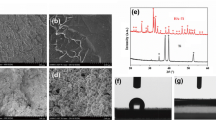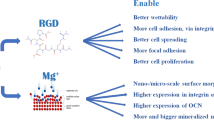Abstract
The incorporation of zinc into the hydroxyapatite structure (ZnHA) has been proposed to stimulate osteoblast proliferation and differentiation. Another approach to improve cell adhesion and hydroxyapatite (HA) performance is coating HA with adhesive proteins or peptides such as RGD (arginine–glycine–aspartic acid). The present study investigated the adhesion of murine osteoblastic cells to non-sintered zinc-substituted HA disks before and after the adsorption of RGD. The incorporation of zinc into the HA structure simultaneously changed the topography of disk’s surface on the nanoscale and the disk’s surface chemistry. Fluorescence microscopy analyses using RGD conjugated to a fluorescein derivative demonstrated that ZnHA adsorbed higher amounts of RGD than non-substituted HA. Zinc incorporation into HA promoted cell adhesion and spreading, but no differences in the cell density, adhesion and spreading were detected when RGD was adsorbed onto ZnHA. The pre-treatment of disks with fetal bovine serum (FBS) greatly increased the cell density and cell surface area for all RGD-free groups, overcoming the positive contribution of zinc to cell adhesion. The presence of RGD on the ZnHA surface impaired the effects of FBS pre-treatment possibly due to competition between FBS proteins and RGD for surface binding sites.











Similar content being viewed by others
References
Salgado PC, Oliveira AM, Oliveira RC, Calasans-Maia MD, Rodrigues CR, Coelho PG, et al. Bone remodeling, biomaterials and technological applications: revisiting basic concepts. J Biomater Nanobiotechnol. 2011;2(3):319–28.
Zambuzzi WF, Coelho PG, Alves GG, Granjeiro JM. Intracellular signal transduction as a factor in the development of “smart” biomaterials for bone tissue engineering. Biotechnol Bioeng. 2011;108(6):1246–50.
Matsumoto T, Okazaki M, Nakahira A, Sasaki J, Egusa H, Sohmura T. Modification of apatite materials for bone tissue engineering and drug delivery carriers. Curr Med Chem. 2007;14(25):2726–33.
de Lima I, Alves GG, Soriano CA, Campaneli AP, Gasparoto TH, Ramos ES Jr, et al. Understanding the impact of divalent cation substitution on hydroxyapatite: an in vitro multiparametric study on biocompatibility. J Biomed Mater Res A. 2011;98(3):351–8.
Shepherd JH, Shepherd DV, Best SM. Substituted hydroxyapatites for bone repair. J Mater Sci Mater Med. 2012;23(10):2335–47.
Patel N, Brooks RA, Clarke MT, Lee PM, Rushton N, Gibson IR, et al. In vivo assessment of hydroxyapatite and silicate-substituted hydroxyapatite granules using an ovine defect model. J Mater Sci Mater Med. 2005;16(5):429–40.
Wu X, Itoh N, Taniguchi T, Nakanishi T, Tatsu Y, Yumoto N, et al. Zinc-induced sodium-dependent vitamin C transporter 2 expression: potent roles in osteoblast differentiation. Arch Biochem Biophys. 2003;420(1):114–20.
Storrie H, Stupp SI. Cellular response to zinc-containing organoapatite: an in vitro study of proliferation, alkaline phosphatase activity and biomineralization. Biomaterials. 2005;26(27):5492–9.
Yang F, Wen JD, He FM, DE XX, Zhao SF, Yang GL. Osteoblast response to porous titanium surfaces coated with zinc-substituted hydroxyapatite. Oral Surg Oral Med Oral Pathol Oral Radiol Endod 2012;113(3):313–18.
de Lima I, Alves GG, Fernades GVO, Dias EP, Soares GA, Granjeiro JM. Evaluation of the in vivo biocompatibility of hydroxyapatite granules incorporated with zinc ions. Material Res. 2010;13(4):563–8.
Balasundaram G, Sato M, Webster TJ. Using hydroxyapatite nanoparticles and decreased crystallinity to promote osteoblast adhesion similar to functionalizing with RGD. Biomaterials. 2006;27(14):2798–805.
Ribeiro N, Sousa SR, Monteiro FJ. Influence of crystallite size of nanophased hydroxyapatite on fibronectin and osteonectin adsorption and on MC3T3-E1 osteoblast adhesion and morphology. J Colloid Interf Sci. 2010;351(2):398–406.
Anselme K. Osteoblast adhesion on biomaterials. Biomaterials. 2000;21(7):667–81.
Yang C, Cheng K, Weng W, Yang C. Immobilization of RGD peptide on HA coating through a chemical bonding approach. J Mater Sci Mater Med. 2009;20(11):2349–52.
He J, Huang T, Gan L, Zhou Z, Jiang B, Wu Y, et al. Collagen-infiltrated porous hydroxyapatite coating and its osteogenic properties: in vitro and in vivo study. J Biomed Mater Res A. 2012;100A(7):1706–15.
Hennessy KM, Clem WC, Phipps MC, Sawyer AA, Shaikh FM, Bellis SL. The effect of RGD peptides on osseointegration of hydroxyapatite biomaterials. Biomaterials. 2008;29(21):3075–83.
Sawyer AA, Hennessy KM, Bellis SL. The effect of adsorbed serum proteins, RGD and proteoglycan-binding peptides on the adhesion of mesenchymal stem cells to hydroxyapatite. Biomaterials. 2007;28(3):383–92.
Sawyer AA, Hennessy KM, Bellis SL. Regulation of mesenchymal stem cell attachment and spreading on hydroxyapatite by RGD peptides and adsorbed serum proteins. Biomaterials. 2005;26(13):1467–75.
Sun L, Berndt CC, Khor KA, Cheang HN, Gross KA. Surface characteristics and dissolution behavior of plasma-sprayed hydroxyapatite coating. J Biomed Mater Res. 2002;62(2):228–36.
Ramesh ST, Rameshbabu N, Gandhimathi R, Nidheesh PV, Srikanth Kumar M. Kinetics and equilibrium studies for the removal of heavy metals in both single and binary systems using hydroxyapatite. Appl Water Sci. 2012;2:187–97.
Sawyer AA, Weeks DM, Kelpke SS, McCracken MS, Bellis SL. The effect of the addition of a polyglutamate motif to RGD on peptide tethering to hydroxyapatite and the promotion of mesenchymal stem cell adhesion. Biomaterials. 2005;26(34):7046–56.
Thompson P, Cox DE, Hastings JB. Rietveld Refinement of Debye-Scherrer Synchrotron X-ray data from Al2O3. J Appl Crystallogr. 1987;20:79–83.
Venkatasubbu GD, Ramasamy S, Ramakrishnan V, Avadhani GS, Thangavel R, Kumar J. Investigations on zinc doped nanocrystalline hydroxyapatite. Int J Nanosci Nanotechnol. 2011;2(1):1–23.
Ren F, Xin R, Ge X, Leng Y. Characterization and structural analysis of zinc-substituted hydroxyapatites. Acta Biomater. 2009;5(8):3141–9.
Cullity BD. Elements of X-ray diffraction. Pearson: Addison-Wesley Publishing Company; 1978.
Mavropoulos E, Costa AM, Costa LT, Achete CA, Mello A, Granjeiro JM, et al. Adsorption and bioactivity studies of albumin onto hydroxyapatite surface. Colloids Surf B Biointerf. 2011;83(1):1–9.
Jackson M, Choo LP, Watson PH, Halliday WC, Mantsch HH. Beware of connective tissue proteins: assignment and implications of collagen absorptions in infrared spectra of human tissues. Biochim Biophys Acta. 1995;1270(1):1–6.
Dong A, Prestrelski SJ, Allison SD, Carpenter JF. Infrared spectroscopic studies of lyophilization- and temperature-induced protein aggregation. J Pharm Sci. 1995;84(4):415–24.
Mitri F, Alves G, Fernandes G, Konig B, Rossi AJ, Granjeiro J. Cytocompatibility of porous biphasic calcium phosphate granules with human mesenchymal cells by a multiparametric assay. Artif Organs 2012;36(6):535–42.
Tsang EJ, Arakawa CK, Zuk PA, Wu BM. Osteoblast interactions within a biomimetic apatite microenvironment. Ann Biomed Eng. 2011;39(4):1186–200.
Kumar GS, Girija EK, Thamizhavel A, Yokogawa Y, Kalkura SN. Synthesis and characterization of bioactive hydroxyapatite-calcite nanocomposite for biomedical applications. J Colloid Interf Sci. 2010;349(1):56–62.
Malik MA, Puleo DA, Bizios R, Doremus RH. Osteoblasts on hydroxyapatite, alumina and bone surfaces in vitro: morphology during the first 2 h of attachment. Biomaterials. 1992;13(2):123–8.
Lamers E, van Horrosen R, te Reit J, van Delft FC, Luttge R, Walboomers XF, et al. The influence of nanoscale topographical cues on initial osteoblast morphology and migration. Eur Cell Mater. 2010;20:329–43.
Okada S, Ito H, Nagai A, Komotori J, Imai H. Adhesion of osteoblast-like cells on nanostructured hydroxyapatite. Acta Biomater. 2010;6(2):591–7.
Rouahi M, Champion E, Gallet O, Jada A, Anselme K. Physico-chemical characteristics and protein adsorption potential of hydroxyapatite particles: influence on in vitro biocompatibility of ceramics after sintering. Colloids Surf B Biointerf. 2006;47(1):10–9.
Acknowledgments
The authors would like to thank CNPq, CAPES and FAPERJ for financial support. IME and LABNANO/CBPF for support with the SEM analysis; Jessica Dornelas, Suzana Anjos and Luciana Consentino for support with the in vitro tests and Priscila Lotsch for the mycoplasma verification assay. We also acknowledge the Brazilian Nanotechnology National Laboratory at Brazilian Center for Research in Energy and Materials for the electron microscopy facilities.
Author information
Authors and Affiliations
Corresponding author
Rights and permissions
About this article
Cite this article
Mavropoulos, E., Hausen, M., Costa, A.M. et al. The impact of the RGD peptide on osteoblast adhesion and spreading on zinc-substituted hydroxyapatite surface. J Mater Sci: Mater Med 24, 1271–1283 (2013). https://doi.org/10.1007/s10856-013-4851-3
Received:
Accepted:
Published:
Issue Date:
DOI: https://doi.org/10.1007/s10856-013-4851-3




